Frontiers Interaction + Infrastructure = Innovations in Healthy Aging
Identical twins Pearl and Ida Nowak* were born in Montana in 1929. Despite the Great Depression and World War II, Pearl says they had a happy childhood, growing up with both parents, a younger sister, and beloved pets. After college, Pearl moved to San Diego and became a teacher, while Ida stayed in the Northwest and became a librarian. Both married, had children, and by most measures, led similarly happy, productive lives.
Ida died of heart disease at age 84. Pearl, however, beat chronic lymphocytic leukemia at age 50, and now, at age 95, is still doing well. Although Pearl has declined physically since she had a fall two years ago, mentally she’s nearly as sharp as ever.
What accounts for the differences in health and life span between Pearl and Ida? Clearly, genetics—which are the same for identical twins—cannot be the only factor in how well we age.
The issue of how we age is becoming increasingly important as the age distribution in American society is shifting toward a much older population. The number of people over the age of 65 has more than doubled since 1970, and those over 85 have tripled. People over 65 are expected to comprise nearly one-quarter of the population by 2050.
Although the average life span is currently much longer than before, individuals are not necessarily healthier, since aging is by far the biggest risk factor for most human diseases and overall functional decline. In 2019, the National Center for Health Statistics reported that 83 percent of Americans aged 60–79 are taking one or more prescription drugs, while 34 percent are on five or more, with the most common being beta-blockers, cholesterol-lowering agents, and antidiabetic medications.
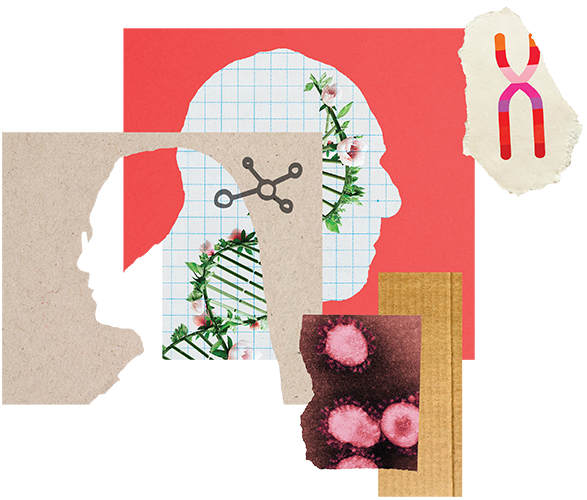
American society is shifting toward a much older population. The number of people over the age of 65 has more than doubled since 1970, and those over 85 have tripled.
Thus, there is an urgent need to understand aging’s biological underpinnings, with the ultimate goal of finding interventions that increase the number of healthy and productive years of human life, known as our health span.
To address that need, Salk has established the Healthy Aging Initiative, part of the Institute’s Campaign for Discovery, a seven-year, $750 million comprehensive fundraising effort to expand Salk’s deep expertise by attracting additional exceptional talent and taking advantage of recent technological innovations to address six important research areas: healthy aging, cancer, immunobiology, neuroscience, plant biology, and computational biology.
Recognizing that everybody ages at a different rate and manner depending on their unique genetics, lifestyle, and environment (and how these factors interact), the Healthy Aging Initiative aims to focus resources on fundamental aging and health-span research that will inform the development of personalized health-span interventions.
In order to ensure success, Salk is relying on its time-tested formula: interaction + infrastructure = innovations.
Inter(a)ction
“Other aging centers focus mainly on individual themes like DNA damage or mitochondria or inflammation, among others. But that is not our approach,” says Professor and newly appointed Chief Science Officer Jan Karlseder. “At Salk, we have experts in all of the different disciplines relevant to the aging process, and our strength is that we all influence and elevate each other with our expertise.”
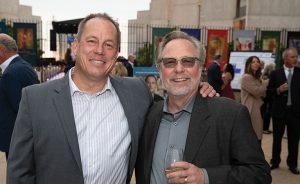
Karlseder and Professor Gerald Shadel routinely go to each other’s lab meetings. It’s not something you’d expect from scientists in two different fields. Karlseder’s lab studies telomere biology—specifically, how telomeres (the protective caps on chromosomes) prevent cancer formation. Shadel’s lab studies the role mitochondria (the powerhouses of the cell) play in human disease, aging, and the immune system.
But at Salk, such cross-disciplinary interactions are common. As Salk President Gerald Joyce has said, “Innovation often emerges at the intersection of scientific disciplines.”
From their interactions, Karlseder, holder of the Donald and Darlene Shiley Chair, and Shadel, holder of the Audrey Geisel Chair in Biomedical Science, discovered some intriguing similarities related to inflammatory signaling pathways. They decided to team up on a study, which they published last year.
The duo discovered that, when telomeres become very short, they communicate with mitochondria, which sets off an inflammatory response that destroys cells that could otherwise become cancerous. Their finding was surprising in that three different hallmarks of aging—shortened telomeres, mitochondrial signaling, and immune inflammation—were teaming up to prevent an additional consequence of aging: cancer. Someone studying only telomeres or only mitochondria or only cancer would not have come across this connection.
Karlseder and Shadel plan to further examine the molecular details of these pathways and explore the therapeutic potential of targeting them to prevent or treat cancer and autoimmune diseases. Their study illustrates the complexity of both biological systems and disease, and highlights the advantage of Salk’s cross-disciplinary approach to identifying novel avenues for developing treatments for disease.

Half of Americans aged 45 to 84 have atherosclerosis—the buildup of artery-blocking plaques—which can lead to heart attacks, strokes, and vascular dementia.
Infrastructure2
Besides Salk’s communicative culture, what makes studies like Karlseder’s and Shadel’s possible is the Institute’s unique infrastructure, both physical and organizational.
GLENN CENTER
Inside Salk frequently mentions how Salk labs’ physical structure—open, not siloed by field—promotes cross-disciplinary synergy, but so do the Institute’s organizational structures, such as the Paul F. Glenn Center for Biology of Aging Research. The Glenn Center, which Karlseder and Shadel co-lead, was established in 2009 with a $5 million grant from the Glenn Foundation for Medical Research. The center’s successes have led to continued funding by the Glenn Foundation.
“Salk started nucleating aging research at least 15 years ago through the Glenn Foundation, and that led to our interacting and thinking about aging before many other institutions did,” says Shadel.
Over the years, Glenn Center investigators have made many significant discoveries about aging; here are some of the most recent:

Professor John Reynolds, holder of the Fiona and Sanjay Jha Chair in Neuroscience, identified a possible reason why half of older adults experience short-term memory problems: dysfunctional mitochondria at synapses (the connections between neurons) fail to meet energetic demand, supplying either too much or too little power. This energy mismatch may contribute to age-related memory loss.
Immune system T cells become less effective with age, but cancer becomes more likely to occur—a double whammy, since T cells fight infections and cancer. Professor Susan Kaech, director of Salk’s NOMIS Center for Immunobiology and Microbial Pathogenesis, has discovered how stress—acute or over a lifetime—is partly to blame. When we are stressed either emotionally or physically (on a cellular level), our bodies respond with “fight-or-flight” mechanisms. In a recent study, Kaech found that in mouse and human tissues beset by cancer or infections, stress hormones released by nerves attract and bind to immune cells, preventing them from working. Kaech says the work reveals how chronic stress can cause immunosuppression that literally makes us sick.
But the team also discovered that beta-blocker drugs—used to control people’s blood pressure and heart rate—can help revive the immune cells. The team’s intervention resulted in more functional immune cells (killer T cells) that were better at destroying cancer. Because beta-blockers are already some of the safest and most widely used medicines for heart disease, the team hopes that this new way to “rejuvenate” immune responses in cancer could be investigated more closely, clinically, to develop more potent and long-lasting cancer-fighting regimens.
“Age brings a myriad of immune changes,” notes Kaech, who holds the NOMIS Chair. “From slower wound healing to weakened cancer surveillance, aging impacts our immunity. Discovering a new way to enhance cancer immunotherapy, especially through repurposing old-but-good drugs, is incredibly exciting.”
Middle age is a time when many metabolic processes become less effective, and disease processes begin. Higher-than-normal blood sugar levels (glucose intolerance) can lead to diabetes, metabolic-dysfunction-associated liver disease, and liver cancer. Professor Satchin Panda, holder of the Rita and Richard Atkinson Chair, studies the genes, molecules, and cells that keep all of our biological clocks (known as circadian rhythms) synchronized. One way to do this is via time-restricted eating, popularly known as intermittent fasting, a dietary regimen that restricts eating to specific hours. In a recent study, Panda found that time-restricted eating was helpful for glucose intolerance in middle-aged mice. The study revealed that time-restricted eating was associated with a lower increase in blood sugar and a faster return to normal blood sugar levels in middle-aged males, with a significant improvement in glucose tolerance in young and middle-aged females. And, while mice are not humans, his study in firefighters (ages 21–59) showed that time-restricted eating significantly improved blood sugar and blood pressure in those who had elevated levels to begin with.
“Circadian rhythms are generally not included in lists of hallmarks of aging, but circadian timetables come into play for all of the diseases of aging,” says Panda. “Strong circadian rhythms in our gut, liver, kidney, muscle, and heart help to optimize our metabolism. They also boost our immune system and help our brain receive and process information. There is even new research showing that circadian rhythms are very important for muscle, tendon, and bone repair and recovery.”

Download the app
Learn more about your own circadian rhythms with an app developed by Salk Professor Satchin Panda and team. Download at mycircadianclock.org.

Half of Americans between ages 45 and 84 have atherosclerosis—the buildup of artery-blocking plaques—and don’t know it. The plaques can lead to heart attacks, strokes, and vascular dementia. Shadel, in another recent collaboration, this time with UC San Diego researchers, found that DNA inside mitochondria, which is maternally inherited, increases the risk for atherosclerosis when it escapes mitochondria and promotes inflammation in immune cells called macrophages. Blocking this pathway in patients with certain mutations that are known to be major risk factors for macrophage-mediated atherosclerosis could form the basis for new treatments.
SHOCK CENTER
Shadel, in addition to co-leading the Glenn Center, is also the director of a newer component of Salk infrastructure: the San Diego Nathan Shock Center of Excellence in the Basic Biology of Aging—a consortium between the Salk Institute, UC San Diego, and Sanford Burnham Prebys. The Shock Center was established in 2020 thanks to a $5 million grant from the National Institute of Aging with the goal of understanding the diversity (“heterogeneity”) of human aging.
The center provides three novel scientific Research Resource Cores to develop new human cell models of aging and enable the integrated analysis of molecular, cellular, and tissue heterogeneity. The Shock Center also promotes research on the basic biology of aging through pilot grant funding, training and mentoring activities of a Research Development Core, and robust outreach efforts.
In late 2022, the Shock Center received funding to enroll participants from the Rancho Bernardo Study of Healthy Aging—one of the longest, continuously National Institutes of Health-funded studies in existence—into the center’s own clinical cohort to study differences in how individuals age at the cellular level. Scientists at the center are collecting skin samples from living Rancho Bernardo Study participants whose individual trajectories of aging have been followed and measured for many years. Using stem cell technology, researchers will be able to transform these samples into other cell types, such as heart muscle cells, neuronal cells, and liver cells, for studies aimed at better understanding the complexity and tissue-specificity of cellular aging.
AHA-ALLEN INITIATIVE
In late 2018, a team of Salk researchers was awarded $19.2 million by the American Heart Association-Allen Initiative in Brain Health and Cognitive Impairment to investigate mechanisms underlying Alzheimer’s disease and age-related cognitive decline and to uncover new therapies. The effort, led by Professor Rusty Gage, holder of the Vi and John Adler Chair for Research on Age-Related Neurodegenerative Disease, is comprehensively analyzing interactions between five areas key to brain health: proteins, genes, metabolism, inflammation, and epigenetics. In typical Salk fashion, scientists with completely different expertise are working on a common challenge: understanding Alzheimer’s.
Salk researchers are investigating Alzheimer’s disease from many different angles, making the idea of effective treatments in our lifetime seem possible.
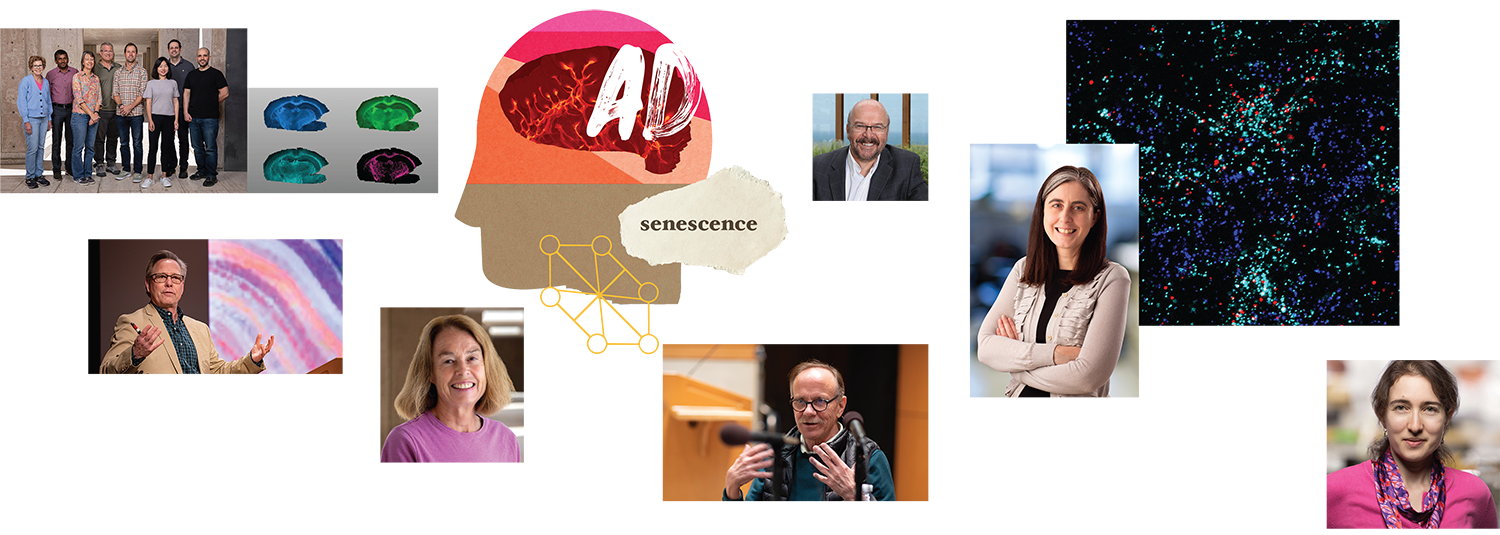
InnO2vations
When talented research teams have supportive infrastructure, innovation is bound to follow. Salk scientists often develop new tools and techniques that revolutionize how research is done.
Because chronological age doesn’t necessarily align with biological age, better biomarkers are needed to help predict disease risk and life span. Salk Professor Tatyana Sharpee and Professor Alexey Terskikh at Sanford Burnham Prebys recently developed an imaging-based approach to quantify aging and its inverse—rejuvenation. Terskikh had developed a new experimental imaging approach to monitor changes in chromatin (DNA plus proteins) and in the epigenetic “tags” attached to DNA in single cells. This experimental approach produces a lot of data obtained at the limit of imaging resolution, and therefore, requires novel statistical methods to extract appropriate signals. Sharpee’s group was working on methods of just this kind, using geometry techniques that capture rapidly expanding data divisions in a tree-like manner. Combining the duo’s experimental and statistical innovations makes it possible to predict biological age more accurately. The approach can also detect how changes at the microscopic cellular levels in blood correlate with organism physiology and behavior, such as sleep and mobility, even among individuals of the same age.
“So much of our understanding of aging is based on population-level data, but that doesn’t really explain what’s going on with any particular individual,” says Sharpee, who holds the Edwin K. Hunter Chair. “The beauty of our new approach is that it advances our understanding of how individual-level biomarkers of aging at the cellular level predict physiologically relevant parameters, which is an important first step in personalized interventions for aging.”
Sharpee is a member of both the Computational Neurobiology Laboratory and the Integrative Biology Laboratory, and also researches how the brain’s billions of neurons use energy and exchange information.
Salk is highly prolific when it comes to innovations in neuroscience, including ways to study Alzheimer’s disease.
While Alzheimer’s disease is one of the top 10 causes of mortality in the US, it’s also uniquely awful in the way it robs people of their identities and relationships with loved ones. Salk researchers are investigating this disease from many different angles, making the idea of effective treatments in our lifetime seem possible.
In 2015, Gage pioneered a method to create brain cells from the skin samples of older people that retained age-related signatures, making the cells invaluable for studying age-related diseases like Alzheimer’s and Parkinson’s. The technique advanced research into brain aging because, before that, “reprogramming” skin cells into stem cells that could be turned into, say, neurons, erased all the signatures of aging. These new techniques are the cornerstone of the aforementioned aging and disease modeling efforts in both the AHA-Allen Initiative and the Shock Center.
More recently, Gage’s lab found that neurons from people with Alzheimer’s disease have a loss of functional activity, impaired metabolism, and increased inflammatory properties. The neurons show deterioration and undergo a late-life stress process called senescence. But administering a custom drug cocktail to the cells reduced the number of senescent neurons to normal levels. The work suggests that targeting senescent cells could be a useful approach for slowing the neuroinflammation and neurodegeneration seen in Alzheimer’s disease.
“Age-related neurodegeneration and the concomitant cognitive decline is inevitable and relentless,” says Gage. “Our goal is to define the cellular and molecular mechanisms that contribute to accelerated decline, as in Alzheimer’s disease. By identifying the molecular mechanisms and the cells that are most affected, we can develop methods of intervention to slow that decline and preserve health. Interestingly, many of the targets we have identified, so far, are cancer-related pathways for which drugs and therapies have been developed. We are currently repurposing cancer drugs for the treatment of age-related cognitive decline.”
Professor Joseph Ecker, holder of the International Council Chair in Genetics and a Howard Hughes Medical Institute investigator, pioneered a method to tag DNA, RNA, and chromatin (DNA plus proteins) in the same cell. The method allows researchers to measure all three types of information simultaneously, and all without destroying the cell, both major innovations. This genomic technology, called snmCAT-seq, took five years to develop and is already proving useful for comparing cells from healthy human brains with those from brains of individuals affected by Alzheimer’s and other neurodegenerative diseases.
Associate Professor Nicola Allen studies astrocytes, star-shaped brain cells that play a key role in helping neurons develop and work properly. She found that neurons and astrocytes work together to form healthy synapses, the connections between neurons. Synapse loss is associated with cognitive impairments, such as those seen in dementia. Allen and her team are studying whether astrocytes can be manipulated to stimulate neurons to repair synapses or form new ones in disorders such as Alzheimer’s disease.
In yet another insight into Alzheimer’s disease, Professor Alan Saghatelian, in collaboration with UC San Diego scientists, discovered that a class of lipids called SGDGs, which change and decline in the brain with age, has anti-inflammatory effects. Saghatelian, holder of the Dr. Frederik Paulsen Chair, says that SGDGs clearly represent a novel piece in the aging puzzle, thereby warranting further study.
Finally, a study by Research Professor Pamela Maher showed how cannabinol (CBN), a non-psychoactive compound derived from cannabis, can protect nerve cells from oxidative damage, a major pathway to cell death. (Brain atrophy from cell death is a prominent feature of Alzheimer’s disease.) She found that CBN works in this context by protecting mitochondria.
Maher is also responsible for a phase 1 clinical trial for CMS121, a compound developed and studied at Salk over the last 15 years. The story of CMS121 illustrates how long it takes to develop therapies derived from basic research. Maher began working on the research that resulted in CMS121 in 2006, but the compound did not reach the clinic until 2022, and will require additional time and money to complete all three phases of clinical trials required to bring a drug to market.
“Our first-in-human study with CMS121 in young and old healthy adults showed good safety and tolerability, so we are now trying to get funding for a trial in early Alzheimer’s disease patients,” says Maher. “We think CMS121 has real promise, as it targets a novel pathway and is also effective against multiple risk factors for Alzheimer’s.”
The time and resources involved in finding effective therapies is significant, which is why, despite Salk’s impressive track record of obtaining funding from NIH, private philanthropy is still crucial for pushing research forward.
The complexity of aging—it’s not just genetic or epigenetic or metabolic or biochemical—suggests that the traditional research model of studying each aspect independently is not the most effective. Instead, the Salk strategy of bringing the best researchers from different areas together, to collectively approach an issue and to inspire each other, offers more promise.
“We are in an exciting new era of research on aging, where we know many of the cellular and molecular processes involved,” says Professor Gerald Shadel. “Given Salk’s long-standing foundational research in aging and age-related diseases—coupled with its unique formula of infrastructure, interdisciplinary collaboration, and integrative approaches—we are uniquely poised to capitalize on support for our Healthy Aging Initiative and fundraising campaign.”

Salk’s President Gerald Joyce is calling 2024 “The Year of Healthy Aging,” reflecting the Institute’s focus on the topic.
Your support adds up—
Donate today to multiply innovations in Healthy Aging research.
Support a legacy where cures begin.
Featured Stories
 Interaction + Infrastructure = Innovations in Healthy AgingSalk formula recalculates aging research, shifting focus to overall resilience and health span.
Interaction + Infrastructure = Innovations in Healthy AgingSalk formula recalculates aging research, shifting focus to overall resilience and health span.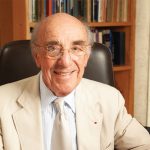 Salk mourns the loss of Nobel Laureate Roger GuilleminThe Institute remembers the “father of neuroendocrinology” for his many contributions to science and friendship to all.
Salk mourns the loss of Nobel Laureate Roger GuilleminThe Institute remembers the “father of neuroendocrinology” for his many contributions to science and friendship to all.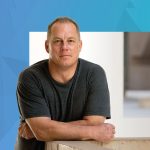 Professor Jan Karlseder named Salk’s Chief Science OfficerOn February 1, Jan Karlseder started as Salk’s new senior vice president and chief science officer (CSO).
Professor Jan Karlseder named Salk’s Chief Science OfficerOn February 1, Jan Karlseder started as Salk’s new senior vice president and chief science officer (CSO). 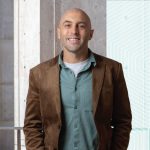 Daniel Hollern–Turning a cancer diagnosis into a career in basic researchAssistant Professor Daniel Hollern pivoted his career trajectory after a family member’s life-changing diagnosis pushed his already-curious mind off a cliff of questions—starting with, “What can I do to help him?”
Daniel Hollern–Turning a cancer diagnosis into a career in basic researchAssistant Professor Daniel Hollern pivoted his career trajectory after a family member’s life-changing diagnosis pushed his already-curious mind off a cliff of questions—starting with, “What can I do to help him?”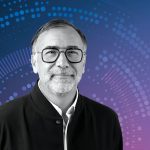 Jerry Sheehan–Collaborating shoulder to shoulder with scientistsWhen you think about a person who heads an information technology department, you might not envision them working shoulder to shoulder with research scientists. But that’s exactly the approach Jerry Sheehan is taking as Salk’s new chief information officer (CIO).
Jerry Sheehan–Collaborating shoulder to shoulder with scientistsWhen you think about a person who heads an information technology department, you might not envision them working shoulder to shoulder with research scientists. But that’s exactly the approach Jerry Sheehan is taking as Salk’s new chief information officer (CIO).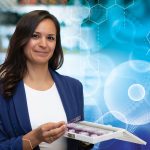 Laura Mainz–Taking control after a cancer diagnosisLaura Mainz grew up in a tiny village in midwestern Germany, with just as many cows as people. But the sweeping landscape speckled with farms never swayed her toward plant biology—instead, her interest in the human body grew.
Laura Mainz–Taking control after a cancer diagnosisLaura Mainz grew up in a tiny village in midwestern Germany, with just as many cows as people. But the sweeping landscape speckled with farms never swayed her toward plant biology—instead, her interest in the human body grew.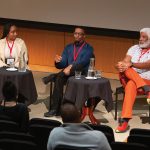 Black Association affinity group cultivates welcoming environmentThe Black Association at Salk (BAS) was one of the first affinity groups formed at Salk in 2020. Since that time, it has established itself as a welcoming space and go-to for resources for all Black Salk community members.
Black Association affinity group cultivates welcoming environmentThe Black Association at Salk (BAS) was one of the first affinity groups formed at Salk in 2020. Since that time, it has established itself as a welcoming space and go-to for resources for all Black Salk community members.




















































